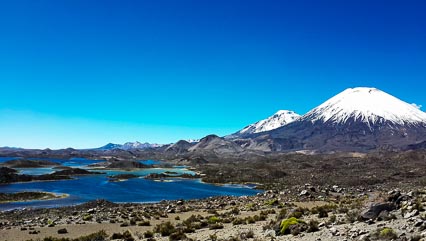Lago Chungara
Lago Chungara is just across the border into Chile at 14,600 feet of altitude. In fact, you will be at the lake before you pass through Chilean immigration.
The lake, set among volcanoes, is spectacular and thus often photographed. You should make a point of looking to the south for Nevado Guallatiri (sometimes Guallatire or Wallatiri), a 19,918 foot high ice-covered stratovolcano with an active vent on its south side. This is one of the most active volcanoes in Northern Chile, and often has smoke rising from its summit. To the north, looming over the lake is Cerro Parinacota. In Aymara, the word for hill (cerro) and mountain (montaña) is the same, “qullu,” which explains why so many impressive mountains are labeled as hills on the maps. Parinacota means “flamingo lagoon” in Aymara, and it is likely that you will see many flamingos standing in the waters of Chungara. The stratovolcano is 20,827 feet high and is potentially active, though it has not erupted for at least 1,400 years. It was an eruption of Parinacota, some 8000 years ago, that blocked off the valley below resulting in Chungara Lake. Behind Parinacota, it’s twin volcano, Pomerape, can be seen over its shoulder from some angles. Pomerape stands 20,610 feet over sea level. Of course, older Tata Sajama, at 21,463 feet, remains the granddaddy volcano of the region.
A couple of miles beyond Chungara Lake you will come upon another sight just as striking, though in a different way. Lagunas de Cotacotani was also formed by volcanic eruptions, but in this case the result is a sprawling mazelike set of lakes and islands in a dry, high desert background with Parinacota and Pomarape, also called los Payachatas (“twins” in Aymara) off to the east. Of course, you will want to keep an eye out while passing both Chungara and Cotacotani. According to legend, both lakes were created by the terrific storm unleashed by nature against two local tribes that opposed the love of two of their members. When the tribes sacrificed the young lovers, the only way they could keep them apart, nature retaliated. The Romeo and Juliet story ends with the death not only of the two star-crossed lovers, but of all the members of their tribes, the creation of the lakes and of the two volcanoes, which are the lover’s tombs. The young couple is said to be seen occasionally traveling together in a canoe on one or other of their two lakes. If you are lucky, though, you are more likely to see the wide variety of waterfowl and the vicuñas that inhabit the area.
On the left side of the road as you pass Cotacotani is a ranger station for Lauca National Park. If you stop, the ranger will need to register your stop. In return, you can get a park pamphlet, with a map and have a look at his cheat sheet on the local flora and fauna. There are often some vendors selling altiplano crafts, but you can usually find a better selection elsewhere.
The ranger station also has public restrooms, but there is no water in them. There are also public restrooms at the border crossing and at the gas station in Tambo Quemado, both of which might be better options. The station also has a couple of camping spots for tents (ChP3,000 per tent, including access to bathrooms and potable water). This is apparently the only place to camp in the park.
To get to Lago Chungara, follow the directions in the article on Getting to Sajama National Park. From Tambo Quemado you just continue west on the main road to the Chilean Border.
Posted: September 28th, 2013 under Altiplano, Birds, Bolivia, Chile, Sajama National Park, South America, Travel.
Tags: Altiplano, Bolivia, Chile, Mountains, Travel
Comments
Write a comment
You need to login to post comments!




Pingback from Larry Memmott's Blog » The Churches of Curahuara de Carangas and Sajama: In and Near Sajama National Park
Time February 15, 2016 at 10:06 pm
[…] Continuing along the main road past Sajama, in about seven miles you will come again to the La Paz-Arica road. Take a right turn here for the short jaunt (1.5 miles) to Lagunas, where the last of the chapels on our list stands. From Lagunas, you can also continue on to Chile, visiting Lago Chungara and the Lagunas de Cotacotani in Sajama’s Chilean sister park, the Lauca Nationa…. […]